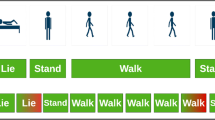Abstract
In a human-centric smart space, Activities of Daily Living (ADL) analysis can provide very useful information for elder care and long-term care services. ADL is defined as an assessment of a person’s functional status. Many recent researches concentrate on designing a good Context Aware Computing System to automate the actions necessarily triggered by ADL recognitions. Implementing a correct ADL recognition engine is a hard work, but will repay the system with lower inference errors and higher system dependability. A good ADL recognition engine is required to adjust its inference strategy based on the learning capability in order to avoid a high error rate, especially in real world inputs with a significant difference as compared to those in the training phase. In this paper, we proposed a powerful inference engine based on the Hidden Markov Model, called the Adaptive Learning Hidden Markov Model (ALHMM), which combines the Viterbi and Baum–Welch algorithms to enhance the accuracy and learning capability. The assessments of ALHMM are conducted on the Python platform and show the practical feasibility of Activity Recognition in residential homes. Such a technique can provide the key answer required for advancing the state-of-the-art in context-aware computing and applications in real life.
Similar content being viewed by others
References
Ayala M, Adjouadi M (2003) An optimized artificial neural network approach for epileptiform activity recognition. In: Proceedings of the IASTED international conference on modeling and simulation, ISBN: 0-88986-337-7, Palm Springs, CA, USA, February, pp 342–347
Baum EL, Petrie T, Soules G, Weiss N (1970) A maximization technique occurring in the statistical analysis of probabilistic functions of Markov chains. Ann Math Stat 41(1):164–171. doi:10.1214/aoms/1177697196
Bodor R, Jackson B, Papanikolopoulos N (2003) Vision-based human tracking and activity recognition. In: Proceedings of the 11th Mediterranean conf on control and automation, Jun 2003
Freitag D, McCallum A (1999) Information extraction with HMMs and shrinkage. In: Proceedings of the AAAI-99 workshop on machine learning for information extraction
Freitag D, McCallum A (2000) Information extraction with HMM structures learned by stochastic optimization. In: AAAI/IAAI 2000, pp 584–589
Oliver N, Horvitz E, Garg A (2002) Layered representations for human activity recognition. In: Multimodal interfaces, proceedings, fourth IEEE int’l conf on 14–16 Oct, pp 3–8
Oliver N, Horvitz E (2005) A comparison of HMMs and dynamic Bayesian networks for recognizing office activities. User modeling, pp 199–209
Patterson D et al (2005) Fine-grained activity recognition by aggregating abstract object usage. In: Ninth IEEE international symposium on wearable computers (ISWC 2005), Osaka, Japan, 18–21 October, pp 44–51
Rabiner LR (1989) A tutorial on hidden Markov models and selected applications in speech recognition. Proc IEEE 77(2):257–286
Scheffer T, Decomain C, Wrobel S (2001) Active hidden Markov models for information extraction. In: Lecture notes in computer science, vol 2189. Springer, Berlin, pp 309–318
Scheffer T, Wrobel S, Popov B, Ognianov D, Decomain C, Hoche S (2001) Learning hidden Markov models for information extraction actively from partially labeled text. Technical report, University of Magdeburg
Seymore K, Mccallum A, Rosenfeld R (1999) Learning hidden Markov model structure for information extraction. In: AAAI 99 workshop on machine learning for information extraction
Viterbi AJ (1967) Error bounds for convolutional codes and an asymptotically optimal decoding algorithm. IEEE Trans Inf Theory IT-13(3):260–269
Author information
Authors and Affiliations
Corresponding author
Rights and permissions
About this article
Cite this article
Cheng, BC., Tsai, YA., Liao, GT. et al. HMM machine learning and inference for Activities of Daily Living recognition. J Supercomput 54, 29–42 (2010). https://doi.org/10.1007/s11227-009-0335-0
Received:
Accepted:
Published:
Issue Date:
DOI: https://doi.org/10.1007/s11227-009-0335-0




